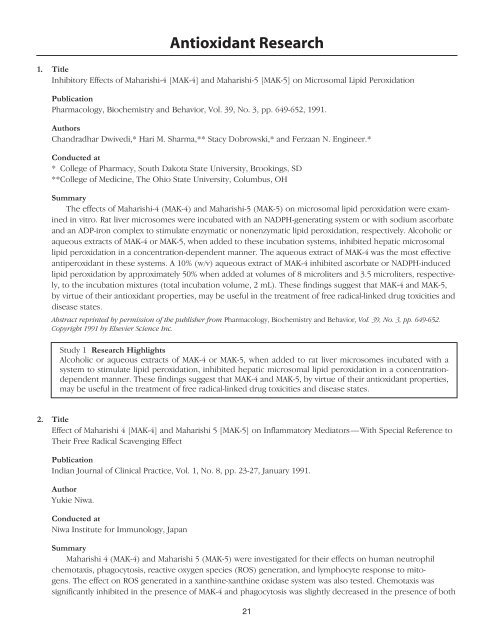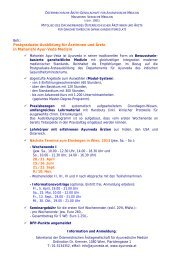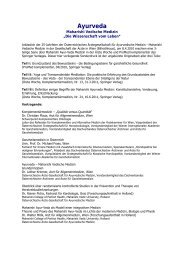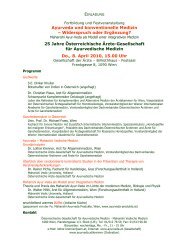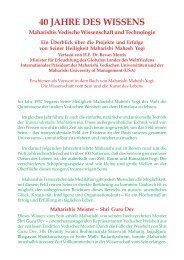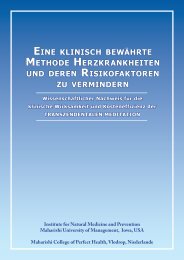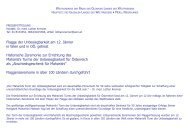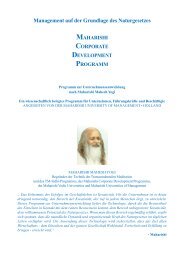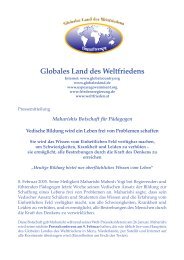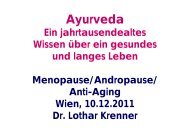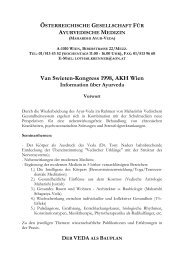Summary of Research Findings
Summary of Research Findings
Summary of Research Findings
Create successful ePaper yourself
Turn your PDF publications into a flip-book with our unique Google optimized e-Paper software.
Antioxidant <strong>Research</strong><br />
1. Title<br />
Inhibitory Effects <strong>of</strong> Maharishi-4 [MAK-4] and Maharishi-5 [MAK-5] on Microsomal Lipid Peroxidation<br />
Publication<br />
Pharmacology, Biochemistry and Behavior, Vol. 39, No. 3, pp. 649-652, 1991.<br />
Authors<br />
Chandradhar Dwivedi,* Hari M. Sharma,** Stacy Dobrowski,* and Ferzaan N. Engineer.*<br />
Conducted at<br />
**College <strong>of</strong> Pharmacy, South Dakota State University, Brookings, SD<br />
**College <strong>of</strong> Medicine, The Ohio State University, Columbus, OH<br />
<strong>Summary</strong><br />
The effects <strong>of</strong> Maharishi-4 (MAK-4) and Maharishi-5 (MAK-5) on microsomal lipid peroxidation were examined<br />
in vitro. Rat liver microsomes were incubated with an NADPH-generating system or with sodium ascorbate<br />
and an ADP-iron complex to stimulate enzymatic or nonenzymatic lipid peroxidation, respectively. Alcoholic or<br />
aqueous extracts <strong>of</strong> MAK-4 or MAK-5, when added to these incubation systems, inhibited hepatic microsomal<br />
lipid peroxidation in a concentration-dependent manner. The aqueous extract <strong>of</strong> MAK-4 was the most effective<br />
antiperoxidant in these systems. A 10% (w/v) aqueous extract <strong>of</strong> MAK-4 inhibited ascorbate or NADPH-induced<br />
lipid peroxidation by approximately 50% when added at volumes <strong>of</strong> 8 microliters and 3.5 microliters, respectively,<br />
to the incubation mixtures (total incubation volume, 2 mL). These findings suggest that MAK-4 and MAK-5,<br />
by virtue <strong>of</strong> their antioxidant properties, may be useful in the treatment <strong>of</strong> free radical-linked drug toxicities and<br />
disease states.<br />
Abstract reprinted by permission <strong>of</strong> the publisher from Pharmacology, Biochemistry and Behavior, Vol. 39, No. 3, pp. 649-652.<br />
Copyright 1991 by Elsevier Science Inc.<br />
Study 1 <strong>Research</strong> Highlights<br />
Alcoholic or aqueous extracts <strong>of</strong> MAK-4 or MAK-5, when added to rat liver microsomes incubated with a<br />
system to stimulate lipid peroxidation, inhibited hepatic microsomal lipid peroxidation in a concentrationdependent<br />
manner. These findings suggest that MAK-4 and MAK-5, by virtue <strong>of</strong> their antioxidant properties,<br />
may be useful in the treatment <strong>of</strong> free radical-linked drug toxicities and disease states.<br />
2. Title<br />
Effect <strong>of</strong> Maharishi 4 [MAK-4] and Maharishi 5 [MAK-5] on Inflammatory Mediators—With Special Reference to<br />
Their Free Radical Scavenging Effect<br />
Publication<br />
Indian Journal <strong>of</strong> Clinical Practice, Vol. 1, No. 8, pp. 23-27, January 1991.<br />
Author<br />
Yukie Niwa.<br />
Conducted at<br />
Niwa Institute for Immunology, Japan<br />
<strong>Summary</strong><br />
Maharishi 4 (MAK-4) and Maharishi 5 (MAK-5) were investigated for their effects on human neutrophil<br />
chemotaxis, phagocytosis, reactive oxygen species (ROS) generation, and lymphocyte response to mitogens.<br />
The effect on ROS generated in a xanthine-xanthine oxidase system was also tested. Chemotaxis was<br />
significantly inhibited in the presence <strong>of</strong> MAK-4 and phagocytosis was slightly decreased in the presence <strong>of</strong> both<br />
21


